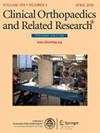Short-term Squatting Mechanics After Arthroscopic Treatment for Femoroacetabular Impingement in Adolescents.
IF 4.2
2区 医学
Q1 ORTHOPEDICS
引用次数: 0
Abstract
BACKGROUND Femoroacetabular impingement (FAI) results from overcoverage of the acetabulum or excess bone on the femoral head-neck junction, which may cause pain or discomfort with repetitive hip flexion. Previous studies have reported adaptations in squat mechanics in individuals with FAI compared with controls, but to our knowledge, there has been little research exploring pre- to postoperative deviations in adolescents. QUESTIONS/PURPOSES (1) Does surgical treatment result in measurable improvements in maximum squat depth? (2) Does surgical intervention alter the individual's balance control strategy during squatting? (3) Are there kinematic changes at specific movement milestones within the squat cycle after surgery? (4) Does the overall squat strategy, encompassing the entire movement, exhibit postoperative changes? METHODS A retrospective analysis was conducted of patients enrolled between February 2016 and July 2023 in a large prospective study evaluating lower extremity biomechanical outcomes after various hip surgeries. Sixty hips were identified meeting specific criteria: (1) absence of neurological or syndromic abnormalities, (2) diagnosis of symptomatic idiopathic FAI through radiographic assessment, (3) scheduled for arthroscopic hip preservation surgery performed by one orthopaedic surgeon, and (4) tested in our motion capture lab before surgery. Of the 60, patients with bilateral symptomatic FAI were excluded as were those who had undergone previous surgical treatment, leaving 43 patients. In all, 79% (34 of 43) of patients completed the target squat that was analyzed in this study, and 65% (22 of 34) of patients completed the same task at their postoperative visit 8 to 16 months after surgery. Sagittal plane segment and joint angles as well as foot progression angle were analyzed across the squat cycle at four key movement milestones: maximum squat depth, preoperative maximum squat depth, maximum pelvic tilt, and maximum hip flexion. Pelvic tilt and hip flexion were plotted versus squat depth and versus each other throughout the squat task with the area between the descent and ascent curves calculated to quantify motion in the sagittal plane. RESULTS Median (range) maximum squat depth (preoperative 27 [13 to 38] versus postoperative 28 [17 to 40], median difference 1 [95% CI 1 to 5]; p = 0.02) increased postoperatively. Balance control strategies showed minimal changes, as the only notable difference was increased trunk flexion during the postoperative squat (preoperative 44 [6 to 65] versus postoperative 47 [18 to 74], median difference 3 [95% CI 1 to 13]; p = 0.01). Increased knee flexion was observed at both the maximum squat depth (preoperative 112 [71 to 135] versus postoperative 117 [78 to 144], median difference 5 [95% CI -1 to 14]; p = 0.02) and maximum hip flexion (preoperative 112 [71 to 132] versus postoperative 117 [78 to 144], median difference 5 [95% CI -1 to 14]; p = 0.02) positions. Pelvic tilt, hip flexion, and foot progression angles demonstrated no differences at the maximum squat depth, maximum pelvic tilt, or maximum hip flexion positions during the squat. Median (range) sagittal plane ROM increased for the trunk (preoperative 43 [16 to 66] versus postoperative 52 [25 to 75], median difference 9 [95% CI 2 to 16]; p = 0.01), pelvis (preoperative 24 [13 to 37] versus postoperative 27 [15 to 44], median difference 3 [95% CI 1 to 7]; p = 0.02), hip (preoperative 98 [76 to 116] versus postoperative 103 [89 to 130], median difference 5 [95% CI 0 to 8]; p = 0.046), and knee (preoperative 112 [73 to 141] versus postoperative 124 [87 to 152], median difference 12 [95% CI 3 to 15]; p = 0.02). CONCLUSION Based on these findings, the squat task could be used as a functional tool for clinicians to quickly assess a patient's abilities before and after surgical treatment. Future research should explore longitudinal studies to assess biomechanical changes over time and to consider whether standardized postoperative rehabilitation in adolescents alters the squat pattern for patients with FAI. LEVEL OF EVIDENCE Level III, therapeutic study.关节镜治疗青少年股髋臼撞击后的短期下蹲力学。
背景:股髋臼撞击(FAI)是由于髋臼过度覆盖或股骨头颈交界处的骨头过多引起的,这可能会引起反复髋关节屈曲时的疼痛或不适。先前的研究已经报道了FAI患者与对照组相比在深蹲力学方面的适应性,但据我们所知,很少有研究探讨青少年术前和术后的偏差。(2)手术干预是否会改变个体深蹲时的平衡控制策略?(3)手术后深蹲周期内的特定运动里程碑是否有运动学变化?(4)包括整个动作在内的整体深蹲策略是否出现术后变化?方法回顾性分析2016年2月至2023年7月纳入的一项大型前瞻性研究,评估各种髋关节手术后的下肢生物力学结果。60个髋关节被确定符合特定标准:(1)没有神经或综合征异常,(2)通过影像学评估诊断有症状的特发性FAI,(3)安排由一名骨科医生进行关节镜下髋关节保存手术,(4)术前在我们的运动捕捉实验室进行测试。在这60例患者中,排除了双侧症状性FAI患者以及之前接受过手术治疗的患者,留下43例患者。总的来说,79%(43人中34人)的患者完成了本研究分析的目标深蹲,65%(34人中22人)的患者在术后8至16个月的随访中完成了相同的任务。矢状面节段和关节角度以及足部进展角在整个深蹲周期的四个关键运动里程碑进行分析:最大深蹲深度、术前最大深蹲深度、最大骨盆倾斜和最大髋屈曲。在整个深蹲任务中,绘制骨盆倾斜和髋关节屈曲与深蹲深度的关系,并计算下降曲线和上升曲线之间的面积,以量化矢状面运动。结果中位(范围)最大蹲深(术前27 [13 ~ 38]vs术后28[17 ~ 40],中位差1 [95% CI 1 ~ 5];P = 0.02)。平衡控制策略显示最小的变化,因为唯一显著的差异是术后深蹲时躯干屈曲增加(术前44[6至65]与术后47[18至74],中位差3 [95% CI 1至13];P = 0.01)。在最大深蹲时均观察到膝关节屈曲增加(术前112[71 ~ 135]与术后117[78 ~ 144],中位差为5 [95% CI -1 ~ 14];p = 0.02)和最大髋关节屈曲度(术前112 [71 ~ 132]vs术后117[78 ~ 144],中位差5 [95% CI -1 ~ 14];P = 0.02)。在深蹲时,骨盆倾斜、髋关节屈曲和足部进展角度在最大深蹲深度、最大骨盆倾斜或最大髋关节屈曲位置上没有差异。躯干矢状面ROM中位(范围)增加(术前43[16 ~ 66],术后52[25 ~ 75],中位差9 [95% CI 2 ~ 16];p = 0.01),骨盆(术前24[13 ~ 37]对术后27[15 ~ 44],中位差3 [95% CI 1 ~ 7];p = 0.02),髋关节(术前98 [76 ~ 116]vs术后103[89 ~ 130],中位差5 [95% CI 0 ~ 8];p = 0.046),膝关节(术前112 [73 ~ 141]vs术后124[87 ~ 152],中位差12 [95% CI 3 ~ 15];P = 0.02)。基于这些发现,深蹲任务可以作为临床医生在手术治疗前后快速评估患者能力的功能工具。未来的研究应探索纵向研究,以评估生物力学随时间的变化,并考虑标准化的青少年术后康复是否会改变FAI患者的深蹲模式。证据等级:III级,治疗性研究。
本文章由计算机程序翻译,如有差异,请以英文原文为准。
求助全文
约1分钟内获得全文
求助全文
来源期刊
CiteScore
7.00
自引率
11.90%
发文量
722
审稿时长
2.5 months
期刊介绍:
Clinical Orthopaedics and Related Research® is a leading peer-reviewed journal devoted to the dissemination of new and important orthopaedic knowledge.
CORR® brings readers the latest clinical and basic research, along with columns, commentaries, and interviews with authors.

 求助内容:
求助内容: 应助结果提醒方式:
应助结果提醒方式:


